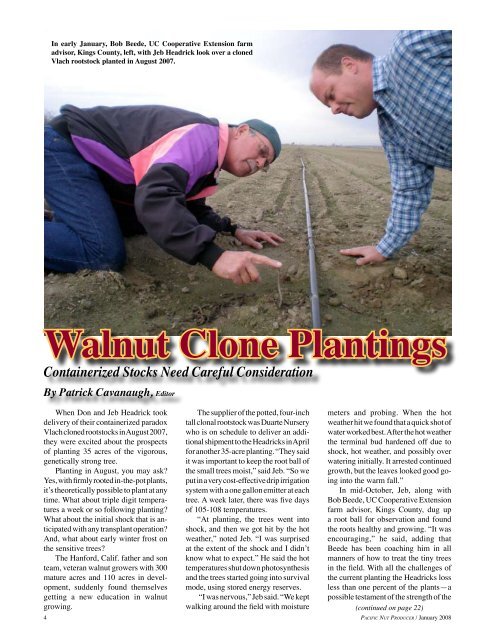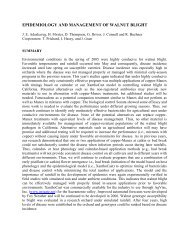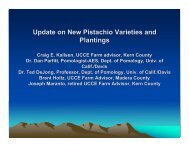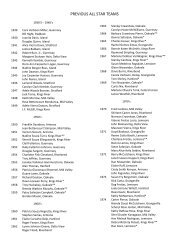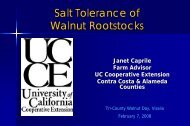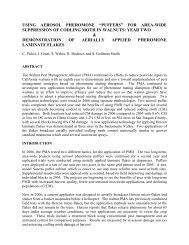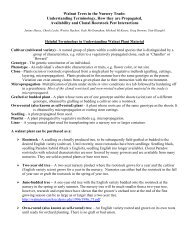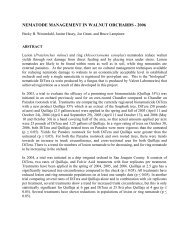Walnut Rootstock Clones - Kings County
Walnut Rootstock Clones - Kings County
Walnut Rootstock Clones - Kings County
Create successful ePaper yourself
Turn your PDF publications into a flip-book with our unique Google optimized e-Paper software.
In early January, Bob Beede, UC Cooperative Extension farm<br />
advisor, <strong>Kings</strong> <strong>County</strong>, left, with Jeb Headrick look over a cloned<br />
Vlach rootstock planted in August 2007.<br />
<strong>Walnut</strong> Clone Plantings<br />
Containerized Stocks Need Careful Consideration<br />
By Patrick Cavanaugh, Editor<br />
When Don and Jeb Headrick took<br />
delivery of their containerized paradox<br />
Vlach cloned rootstocks in August 2007,<br />
they were excited about the prospects<br />
of planting 35 acres of the vigorous,<br />
genetically strong tree.<br />
Planting in August, you may ask<br />
Yes, with firmly rooted in-the-pot plants,<br />
it’s theoretically possible to plant at any<br />
time. What about triple digit temperatures<br />
a week or so following planting<br />
What about the initial shock that is anticipated<br />
with any transplant operation<br />
And, what about early winter frost on<br />
the sensitive trees<br />
The Hanford, Calif. father and son<br />
team, veteran walnut growers with 300<br />
mature acres and 110 acres in development,<br />
suddenly found themselves<br />
getting a new education in walnut<br />
growing.<br />
The supplier of the potted, four-inch<br />
tall clonal rootstock was Duarte Nursery<br />
who is on schedule to deliver an additional<br />
shipment to the Headricks in April<br />
for another 35-acre planting. “They said<br />
it was important to keep the root ball of<br />
the small trees moist,” said Jeb. “So we<br />
put in a very cost-effective drip irrigation<br />
system with a one gallon emitter at each<br />
tree. A week later, there was five days<br />
of 105-108 temperatures.<br />
“At planting, the trees went into<br />
shock, and then we got hit by the hot<br />
weather,” noted Jeb. “I was surprised<br />
at the extent of the shock and I didn’t<br />
know what to expect.” He said the hot<br />
temperatures shut down photosynthesis<br />
and the trees started going into survival<br />
mode, using stored energy reserves.<br />
“I was nervous,” Jeb said. “We kept<br />
walking around the field with moisture<br />
meters and probing. When the hot<br />
weather hit we found that a quick shot of<br />
water worked best. After the hot weather<br />
the terminal bud hardened off due to<br />
shock, hot weather, and possibly over<br />
watering initially. It arrested continued<br />
growth, but the leaves looked good going<br />
into the warm fall.”<br />
In mid-October, Jeb, along with<br />
Bob Beede, UC Cooperative Extension<br />
farm advisor, <strong>Kings</strong> <strong>County</strong>, dug up<br />
a root ball for observation and found<br />
the roots healthy and growing. “It was<br />
encouraging,” he said, adding that<br />
Beede has been coaching him in all<br />
manners of how to treat the tiny trees<br />
in the field. With all the challenges of<br />
the current planting the Headricks loss<br />
less than one percent of the plants—a<br />
possible testament of the strength of the<br />
(continued on page 22)<br />
4 Pa c i f i c Nu t Pr o d u c e r / January 2008


